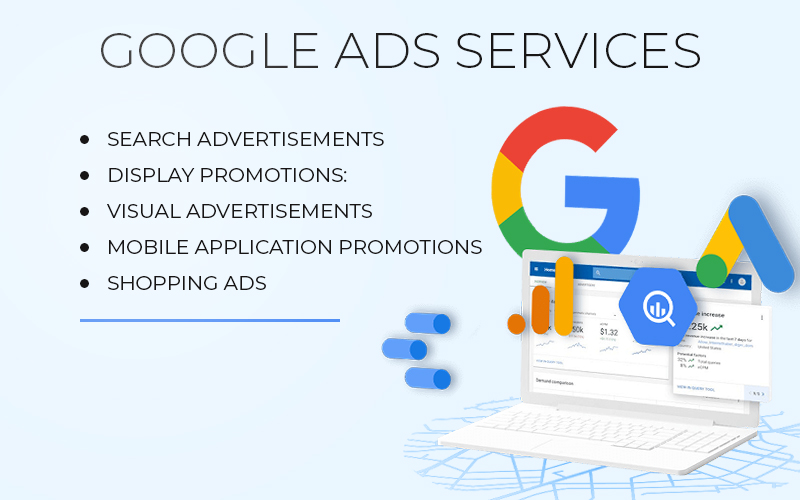In the digital marketing world, choosing the right advertising platform can significantly affect your return on investment. Two giants dominate this space — Google Ads and Meta Ads (formerly Facebook Ads). Marketers often debate: Google Ads vs. Meta Ads — Which Drives Better Performance? The answer isn’t one-size-fits-all. It depends on business goals, audience, industry, and budget. In this article, we’ll break down the core differences, performance metrics, and when to use which platform for maximum ROI.
Understanding the Basics: Google Ads and Meta Ads
Google Ads is a pay-per-click (PPC) platform that serves ads across Google’s Search Network, Display Network, YouTube, Gmail, and more. It’s best known for search intent-based targeting, where your ad appears when someone is actively looking for a solution related to your product or service.
Meta Ads, on the other hand, covers both Facebook and Instagram, offering visually-rich ads to users based on interests, behaviors, and demographics. Meta excels at discovery-based targeting, helping brands build awareness and demand among users who may not be actively searching but are potential buyers.
Audience Intent and Reach
The biggest difference lies in user intent. On Google, users are seeking answers. Ads here meet immediate needs — think of someone searching “emergency plumber near me”. On Meta, users scroll for entertainment or connection, not necessarily to shop or inquire. However, Meta Ads can introduce new products in a visually compelling way, ideal for top-of-the-funnel campaigns.
From a reach perspective:
- Google has over 8.5 billion searches per day.
- Meta reaches over 3.8 billion users across Facebook, Instagram, Messenger, and Audience Network.
Both platforms offer massive reach, but how they reach users differs fundamentally.
Ad Formats and Targeting Capabilities
Google Ads supports text, image, video, shopping, and responsive search ads. Its biggest strengths lie in:
- Search Ads that tap into high buying intent.
- Shopping Ads for eCommerce brands.
- YouTube Ads for visual storytelling.
Meta Ads shines with:
- Image, video, carousel, slideshow, and collection ads.
- Advanced interest-based targeting, custom audiences, and lookalike audiences.
- Seamless integration with Instagram for influencer collaborations and UGC-style content.
Both platforms allow retargeting, geolocation, device targeting, and A/B testing, but Meta’s lookalike audience feature is particularly powerful for scaling.
Performance Metrics and Benchmarks
To evaluate ad performance, marketers commonly look at:
- CTR (Click-through Rate)
- CPC (Cost per Click)
- CPA (Cost per Acquisition)
- ROAS (Return on Ad Spend)
Industry benchmarks show:
- Google Ads typically have higher CPC but also higher conversion intent.
- Meta Ads often enjoy lower CPC, especially for video and carousel formats, but may require multiple touchpoints to convert.
For example, in eCommerce:
- Google Shopping Ads average a 2.1% conversion rate.
- Meta Ads average around 1.1% conversion, but with engaging creatives, this can double.
Budget Efficiency and ROI
When comparing Google Ads vs. Meta Ads, budget efficiency is key. Meta often wins for top-of-funnel traffic due to low CPCs, while Google wins in bottom-of-funnel conversions where intent is high.
A B2B brand targeting decision-makers may benefit from Google’s precise keyword targeting. In contrast, a fashion retailer might get better engagement and awareness via Meta’s visual storytelling and audience segmentation.
That’s why marketers enrolled in a performance marketing course learn to allocate budgets across both platforms depending on funnel stages and campaign goals.
Use Cases: When to Choose Google Ads
Choose Google Ads if:
- You want to capture high-intent traffic.
- You sell services/products people actively search for.
- You run local or emergency services, such as healthcare, plumbing, or legal aid.
- You operate in B2B or high-ticket industries where the research phase is critical.
Google Ads are perfect for driving quick conversions when paired with strong landing pages and keyword optimization.
Use Cases: When to Choose Meta Ads
Use Meta Ads if:
- You aim to build brand awareness and reach.
- Your product benefits from visual appeal.
- You target a broad lifestyle-based audience.
- You want to run video or influencer-driven campaigns.
Meta is powerful for storytelling, retargeting cart abandoners, and creating engaging product showcases.
Cross-Platform Strategy: The Smart Marketer’s Approach
The smartest marketers don’t ask Google Ads vs. Meta Ads as an either/or question. Instead, they integrate both into a cohesive strategy:
- Use Meta Ads to generate demand and awareness.
- Use Google Ads to capture demand as users begin searching.
- Use retargeting ads across both platforms to nurture leads.
For instance, a user might discover a new skincare brand on Instagram, then search for reviews on Google before purchasing. This is a multi-touch journey that thrives on both platforms being used in harmony.
Tracking, Attribution, and AI Evolution
With the rise of AI-powered ad platforms, both Google and Meta have introduced advanced campaign types like Performance Max (Google) and Advantage+ Shopping Campaigns (Meta). These leverage machine learning to optimize creatives, placements, and bidding in real-time.
However, attribution remains a challenge. Google’s last-click model vs. Meta’s view-through conversions can produce differing ROI metrics. Use tools like Google Analytics 4, UTM parameters, and Meta’s Conversion API to ensure better attribution accuracy.
Final Verdict: Which Platform Performs Better?
So, Google Ads vs. Meta Ads — Which Drives Better Performance? The answer is nuanced:
- For high-intent conversions, Google Ads generally outperform.
- For brand building and audience expansion, Meta Ads deliver better.
- For complete funnel strategies, using both provides optimal results.
Test both platforms with small budgets, analyze ROI by campaign goal, and scale accordingly. There’s no silver bullet — only strategic testing and optimization can reveal what works best for your business.


